
We have finally received our new CosMx instrument and looking forward to do 2D transcriptomics at subcellular resolution.
On Tuesday, April 18th, Jørgen Kjems and Mette Galsgaard Malle will give a lecture on the future of RNA medicine. While most are familiar with RNA medicine in the form of COVID-19 vaccines, the development of new types of RNA medicine has taken off in recent years, and it has enormous potential. The lecture is part of the public lectures in Natural Science.
Please note that the lecture will be in Danish.
Find out more and locate a livestream near you at ofn.au.dk/sted/18-04d.

Professor Ulrich F Keyser from Cavendish Laboratory, University of Cambridge, UK and Professor Michael Mayer from Adolphe Merkle Institute, University of Fribourg, Switzerland will give talks at the minisymposium on "Sensing single RNA and protein conformations in solution - Application of plasmonic Optical Tweezers and nanopores"
Get more info here: The Interdisciplinary Nanoscience Center at Aarhus University: Minisymposium (au.dk)

TUESDAY 13 December 2022
Thesis title: Creating nanopore sensors for enhanced molecule detection - a demand for disease diagnosis
Nanopores are nanoscale pores that can be embedded in an electrically insulating membrane, which enable to monitor the changes in ionic current caused by the passage of individual molecules. Nanopores have been a powerful tool for the detection of a variety of biomolecules, such as DNA and proteins. During her PhD studies, Xialin Zhang created different nanopore-based sensors with the aim to enhance the biosensing ability of nanopores with regard to specificity and sensitivity. This was achieved by chemically engineering natural protein nanopores with target-specific ligands and using the bottom-up approach to construct an artificial DNA nanopore using nucleic acids as building blocks. These studies pave the way for creating highly sensitive and high-throughput nanopore sensing devices with potential use in the diagnosis of diseases.
The PhD study was completed at Interdisciplinary Nanoscience Center (iNANO), Faculty of Natural Sciences, Aarhus University.
This summary was prepared by the PhD student.
Time: Tuesday, 13th December 2022 at 13:15
Place: Building 1514, room 213, Aud-I, Department of Chemistry, Aarhus University, 8000, Aarhus
Members of the assessment committee:
Professor Ulrich F. Keyser, Cavendish Laboratory, University of Cambridge, United Kingdom
Professor Michael Mayer, Adolphe Merkle Institute, University of Fribourg, Switzerland
Professor Mingdong Dong (chair), iNANO, Aarhus University, Denmark
Main supervisor:
Professor Jørgen Kjems, iNANO, Aarhus University, Denmark
Language: The PhD dissertation will be defended in English

FRIDAY 2 December 2022
Thesis title: Unrevealling the potential of aptamer-based profiling of dairy products’ protein composition
During his PhD studies, Asger Givskov Jørgensen researched the dynamic changes in the protein composition of bovine milk by utilising a novel aptamer-based method, APTA-SHAPE, that uses highly diverse random aptamer pools as biosensors to profile the protein composition of milk. Extrinsic and intrinsic factors influence the chemical properties of milk, and the study investigated changes in the protein position related to breed, genetic polymorphisms of kappa-casein, shelf-life of skyr, and high heat-treatments effect on whey protein denaturation. Asger Givskov Jørgensen studied how aptamers and the APTA-SHAPE method can be utilised to extend the understanding of bovine milk’s protein composition to improve product quality, profitability, and climate footprint of dairy manufacturing. The new research findings contribute to the development of assays capable of identifying kappa-casein phenotypes in milk, milk authenticity, and an assay for estimating heat-induced whey protein denaturation.
This summary was prepared by the PhD student.
Members of the assessment committee:
Professor Günter Mayer, Life & Medical Sciences Institute (LIMES) Chemical Biology, University of Bonn, Germany
Senior R&D Manager Marie Stampe Ostenfeld, Nutrition & Health, Arla Foods Ingredients, Denmark
Associate Professor Ken Howard (chair), Interdisciplinary Nanoscience Center INANO-MBG, Aarhus University, Denmark
Main supervisor:
Professor Jørgen Kjems, Interdisciplinary Nanoscience Center - INANO-MBG, Aarhus University, Denmark

WEDNESDAY 12 January 2022
Thesis title: Improving binding interactions with multivalency
Many biological processes are mediated by the synergy of multivalent interactions, as for example seen with the entry of influenza virus to a host cell. The principle of multivalency can thus be exploited to enhance cell and tissue targeting for bioimaging purposes and to modulate a response. During her PhD studies, Marjan Omer employed nucleic acids as building blocks for engineering nanoscaffolds of well-defined architectures displaying multivalent ligands to investigate the effect of multivalency in cell uptake and tumor targeting in mouse models. Furthermore, multivalent nanoscaffolds were used to study the molecular requirements for activation of B cells, a crucial component of our immune system, in close collaboration with researchers at the Department of Biomedicine as a part of the research center CellPAT. The PhD project has contributed to the understanding of the role of multivalent interactions in cell and tissue targeting and shed lights on the highly debated B cell activation models, which has significant relevance for the development of effective vaccines.
This summary was prepared by the PhD student.
Members of the assessment committee:
Professor Mark Bathe, Department of Biological Engineering, Massachusetts Institute of Technology (MIT), USA
Professor Kirill Afonin, Department of Chemistry, University of North Carolina, USA
Professor Mingdong Dong (chairman), iNANO, Aarhus University, Denmark
Main supervisor:
Professor Jørgen Kjems, Interdisciplinary Nanoscience Center (iNANO) and Molecular Biology and Genetics, Aarhus University, Denmark
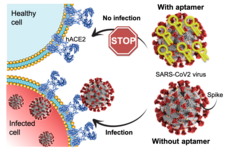
MONDAY 13 DECEMBER
A new research paper from the Kjems lab reports the development of an RNA aptamer with very high binding affinity for the Spike protein that protrudes from the surface of SARS-CoV-2 virus particles. By attaching itself to the virus surface, the RNA aptamer prevents the Spike protein from serving as a key that allows the virus to enter a cell. The RNA aptamer folds into a 3D structure that makes it possible to recognize a specific target molecule of interest. In this way, aptamers can be compared to traditional antibodies, but they are much easier and cheaper to manufacture.
The new study shows that the aptamer efficiently blocks the binding between the Spike protein on the virus and the receptor ACE2 on human cells, thereby neutralising the infection of human cells grown in culture. The study also shows that the RNA aptamer inhibits the first known variants of the virus with comparable efficiency. “Since then, we have continued our studies and been able to show that it also recognizes the delta variant. We are now waiting for samples of the newly identified variant, omicron, so we can test whether the aptamer also recognizes that, ”says Jørgen Kjems. The promising results point towards a possible future use of the aptamer in COVID-19 treatment and towards the development of cheaper and more sensitive diagnostic tests. Julian Valero, the first author on the paper, also highlights the applications beyond COVID-19: 'We can apply this technology to rapidly develop new RNA aptamer molecules targeting emerging SARS-CoV-2 variants or other viral threats'.
External funding: Carlsberg foundation grant number CF20-0045, Danish National Research Foundation grant number DNRF135, EU Horizon2020 grant number 899619
Link to the scientific article: https://www.pnas.org/content/118/50/e2112942118

FRIDAY 10 DECEMBER 2021
Congratulations to postdoc Mette G Malle in the Kjems lab who was just awarded a two-year grant from the Carlsberg foundation for the project: A DNA-based mechanical loop for molecular geometric footprint magnification allows ultra-sensitive detection. The project will be conducted in collaboration between the Wyss Institute at Harvard and iNANO at Aarhus University.
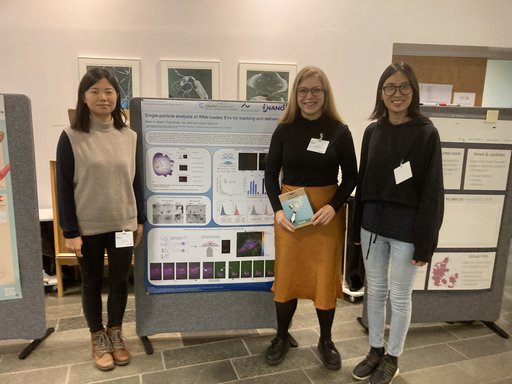
The Danish Society for Extracellular Vesicles held their annual meeting in Vejle on the 28th of October 2021. Postdocs Yan Yan, Mette G Malle and Ping Song from the Kjems lab won the prize for the best poster presentation for their joint work on single-particle analysis of RNA-loaded EVs for tracking and delivery. Congratulations!!

WEDNESDAY 27 October 2021
Thesis title: Circular RNAs – important players in brain development
During her PhD studies, Maria Schertz Andersen researched the role of circular RNAs (circRNAs) in brain development. CircRNAs have the capacity to regulate multiple cellular processes and are especially abundant in the eukaryotic nervous system. Maria Schertz Andersen studied how one of these circRNAs functions during differentiation of human embryonic stem cells into early neural progenitors and cerebral organoids. Furthermore, Maria Schertz Andersen studied different strategies for depletion of circRNAs. The new research findings contribute to the understanding of how circRNAs function during development of the mammalian nervous system and gives insight to the most efficient strategy for depletion of circRNAs in cell culture.
This summary was prepared by the PhD student.
Members of the assessment committee:
Professor Magdalini Polymenidou, Department of Quantitative Biomedicine, University of Zurich, Switzerland Professor Johan Jakobsson, Laboratory of Molecular Neurogenetics, Center Lund Stem Cell Center, Lund University, Sweden Associate professor Ken Howard (chairman), Interdisciplinary Nanoscience Center (iNANO), Aarhus University, Denmark
Main supervisor:
Professor Jørgen Kjems, Interdisciplinary Nanoscience Center (iNANO) and Molecular Biology and Genetics, Aarhus University, Denmark
Co-supervisor:
Associate Professor Lasse Sommer Kristensen, Biomedicine, Aarhus University, Denmark
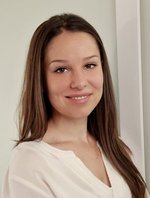
THURSDAY 23 September 2021
Thesis title: Do circular RNAs possess a functional role in the nervous system?
RNAs are essential biomolecules in the regulation of cellular processes both in physiological and pathological conditions. Despite the well-established role of messenger RNAs (mRNAs) as blueprint carrier for protein synthesis, the majority of RNAs in mammalian cells are considered non-coding RNAs (ncRNAs). These do not comprise encoded information for protein production, but can still harbor the potential to regulate gene expression and protein synthesis. Circular RNAs (circRNAs) are a recently discovered example of ncRNAs. In contrast to other ncRNA classes, such as micro RNAs, their role in mammalian brain development and neurodegenerative diseases is to a large extent undeciphered. During her PhD studies, Sabine investigated the function of selected circRNAs in early mammalian brain development as well as characterized the circRNA profile in mammalian models recapitulating the neurodegenerative disease amyotrophic lateral sclerosis (ALS). From this work, a particular circular RNA influencing neural development of mammalian model systems was discovered. Additionally, the studies shed light on alterations of the circular expression profile in ALS models. Her research findings contribute to the discussion on whether circRNAs could possess regulatory functions in the nervous system.
This summary was prepared by the PhD student.
Members of the assessment committee:
Associate Professor Kristine Freude, Department of Veterinary and Animal Sciences, University of Copenhagen, Denmark
Associate Professor Sebastian Kadener, Department of Biology, Brandeis University, USA
Senior Researcher Morten Foss (chairman), iNANO, Aarhus University, Denmark
Main supervisor:
Professor Jørgen Kjems, Interdisciplinary Nanoscience Center (iNANO) and Molecular Biology and Genetics, Aarhus University, Denmark
Co-supervisor:
Associate Professor Lasse Sommer Kristensen, Biomedicine, Aarhus University, Denmark

FRIDAY 13 August 2021
A paper from Jørgen Kjems and colleagues published in Nature Communications presents a new method to determine the full-length sequence and isoform variation of a class of RNAs called circular RNAs. The study is conducted in human and mouse brains and shows that many circRNAs exist in a large number of different version and that a special class of exons, previously linked to autism, are enriched in circRNAs.
When cells read the information encoded in our genes, they do so by creating an RNA copy of the individual gene. RNA molecules are processed in a myriad ways, creating the complexity in gene expression seen in higher organisms. The average gene produces 7 different isoforms, largely through alternative splicing, and this process is particularly active in neurons. Circular RNAs (circRNAs) are a group of highly stable RNAs are enriched in neurons but their entire composition remain unexplored due to their sequence overlap with conventional mRNA.
One of the challenges for understanding circRNA composition is that they have so far only been described using sequencing techniques that read short stretches of RNA. The method presented by Kjems and colleagues solves this problem by developing protocols where circRNAs are specifically enriched and subjected to long-read sequencing using nanopore sequencing technology.
In addition to the laboratory protocol, a novel bioinformatic pipeline for the ONT long-read platform was developed by former MBG/INANO-postdoc Morten Venø - now the CEO of AU spin-out company Omiics. Taken together, this led to the surprizing finding that circRNAs exhibit more diverse splicing events than mRNA with frequent retention of introns and novel exons. Of particular interest, the authors find that a group of exons shorter than 30 nt, the so-called microexons, are preferentially found in circRNAs, rather than in linear RNAs as previously reported. Several of these microexons have been linked to autism, suggesting that the unique composition of circRNAs found in the brain could play a role in neuronal disease.
The article in Nature Communications: Nanopore sequencing of brain-derived full-length circRNAs reveals circRNA-specific exon usage, intron retention and microexons Karim Rahimi, Morten T. Venø, Daniel M. Dupont, Jørgen Kjems
DOI: 10.1038/s41467-021-24975-z
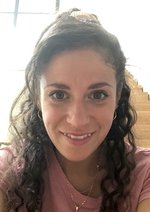
MONDAY 15 Mar 2021
PhD student Sarah Kroer Ochoa will have her qualifying exam (part A) on Monday the 15th of March. Her progress report is entitled 'Applying Nucleic Acid-based Nano scaffolds for Enhanced Molecular Imaging and Multi-specific Interactions in Nanomedicine' and the examiners are:
Associate Professor Stefan Vogel, Department of Physics, Chemistry and Pharmacy, University of Southern Denmark
Associate professor Mingdong Dong, iNANO, Aarhus University
Professor Jørgen Kjems, iNANO and Department of Molecular Biology and Genetics, Aarhus University
MONDAY 1 MAR 2021
oLIVER is a new project funded by the ODIN programme at Aarhus University. The project is a collaboration between Jørgen Kjems at iNANO, Henning Grønbæk at Aarhus University Hospital, Christian B Vægter at Biomedicine and Natascha B Michaelsen at Novo Nordisk. oLIVER's goal is to discover new biomarkers for liver disease through an open science collaborative network
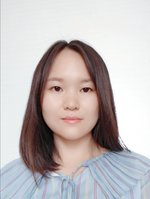
MONDAY 1 Mar 2021
PhD student Xialin Zhang will have her qualifying exam (part A) on Monday the 1st of March. Her progress report is entitled 'Aptamer-functionalized DNA transmembrane nanopore for protein sensing' and the examiners are:
Associate Professor Stefan Vogel, Department of Physics, Chemistry and Pharmacy, University of Southern Denmark
Associate professor Mingdong Dong, iNANO, Aarhus University
Professor Jørgen Kjems, iNANO and Department of Molecular Biology and Genetics, Aarhus University
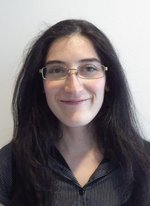
FRIDAY 12 FEB 2021
PhD student Laura Teodori will have her qualifying exam (part A) on Friday the 12th of February. Her progress report is entitled 'Multivalency Effects of Nucleic Acid-based Nanostructures: Applications on Diagnostics and Protein-Sugar Interactions' and the examiners are:
Associate Professor Stefan Vogel, Department of Physics, Chemistry and Pharmacy, University of Southern Denmark
Associate professor Ken Howard, iNANO, Aarhus University
Professor Jørgen Kjems, iNANO and Department of Molecular Biology and Genetics, Aarhus University
Assistant professor Daniel Miotto Dupont, iNANO, Aarhus University
To receive a link to the event, please send an e-mail to Anne Færch Nielsen, afn@inano.au.dk
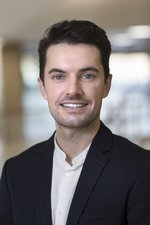
Friday 5 February 2021
Thesis title: CircRNAs: Big new deal in inflamed skin?
During his PhD studies, Liviu I. Moldovan researched the involvement of circRNAs in the inflammatory skin diseases, namely psoriasis and atopic dermatisis (AD). These are two of the most common chronic skin conditions in adults worldwide, with a considerable negative impact on life quality. Liviu I. Moldovan studied the circRNA transcriptome in psoriasis and AD by shedding a light on altered circRNA expression between lesional and non-lesional skin from patients and by contrasting it with skin from healthy individuals. The new research findings raise interesting questions related to new pathophysiological mechanisms in inflammatory skin disease and present compelling evidence for the great biomarker potential of circRNAs.
This summary was prepared by the PhD student.
Members of the assessment committee:
Professor Lone Skov, Department of Dermato-Allergology, Gentofte Hospital, Faculty of Health Sciences, University of Copenhagen, Denmark
Senior researcher Ling-Ling Chen, Shanghai Institute of Biochemistry and Cell Biology, China
Associate Professor Ken Howard (chairman), Interdisciplinary Nanoscience Center (iNANO), Aarhus University, Denmark
Main supervisor:
Professor Jørgen Kjems, Interdisciplinary Nanoscience Center (iNANO) and Molecular Biology and Genetics, Aarhus University, Denmark
Co-supervisor:
Associate Professor Lasse Sommer Kristensen, Biomedicine, Aarhus University, Denmark
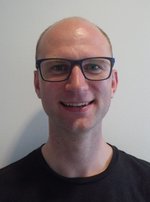
WEDNESDAY 27 JAN 2021
PhD student Asger Givskov Jørgensen will have his qualifying exam (part A) on Wednesday the 27th of January. His progress report is entitled 'Analyzing food ingredients by a novel APTA-SHAPE technology' and the examiners are:
Senior R&D Manager Marie Stampe Ostenfeld, Arla Foods
Associate professor Ken Howard, iNANO, Aarhus University
Professor Jørgen Kjems, iNANO and Department of Molecular Biology and Genetics, Aarhus University
Assistant professor Daniel Miotto Dupont, iNANO, Aarhus University
To receive a link to the event, please send an e-mail to Asger Givskov Jørgensen, asgergivskov@inano.au.dk

FRIDAY 15 JAN 2021
We currently have an opening for a PhD student in the Kjems lab. The application deadline is February 1st.
The project - Multifunctional RNA nanostructures for imaging and therapeutic intervention - aims to create multifunctional RNA-based nanostructures that can image, facilitate targeted delivery and act as gene medicine in diseased tissue with a special focus on cancer, inflammatory and viral diseases. The project will cover areas from conjugation chemistry, aptamer technology, molecular characterization, cell culture assay and testing in pre-clinical model systems. The aim of the project is to provide early diagnosis of disease progression and more effective delivery of drugs with minimal side-effects. The project is conducted in close synergy between multidisciplinary groups at iNANO and international clinicians.
This PhD project is part of the Center for Multifunctional Biomolecular Drug Design - CEMBID - funded by the Novo Nordisk Foundation. Based on interdisciplinary work in chemistry, molecular biology, pharmacology and medicine, CEMBID aims to develop new multifunctional biomolecular drugs, which will pave the way for new types of drugs that are more effective, have fewer side effects and can be adapted to the individual patient.
A full description of the project and the conditions for applying can be found here The Interdisciplinary Nanoscience Center at Aarhus University: About CEMBID (au.dk)
For more information, please contact Prof. Jørgen Kjems (jk@mbg.au.dk)
To apply for this position go to Nanoscience (au.dk)
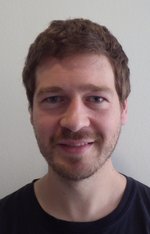
THURSDAY 8 JANUARY 2021
Congratulations to assistant professor Julian Valero who was just awarded a two-year grant from the Lundbeck foundation for the project: Evolving new types of therapeutics - reshuffling old players in new ways.
https://www.lundbeckfonden.com/lf-experiment-2020-lundbeckfonden/

TUESDAY DEC 15 2020
A new collaborative project between the Kjems lab and Henning Grønbæk's research group at Aarhus University Hospital has received funding through ODIN, a new open-science initiative supported by the Novo Nordisk Foundation (https://projects.au.dk/odin/)
The project aims to identify novel biomarkers in blood from NAFLD (non-alcoholic fatty liver disease) and NASH (non-alcoholic steatohepatitis) patients using APTASHAPE, a high-throughput, unbiased screening method based on RNA aptamers. By following changes biomolecule composition in the blood during onset, development and treatment of disease the research team hopes to identify biomarkers that can diagnose and stage patients and monitor treatment response without the need for invasive liver biopsies.
Read more about ODIN and the project here: What is ODIN (au.dk)

MONDAY 19th of October 2020
Circular RNA, a non-coding RNA family enriched in the human brain, has attracted attention by its aging-related biological features and potential clinical applications in neurodegenerative diseases. During her Ph.D. studies, I-Ju Lo focused on the role of circRNAs in multiple Alzheimer’s disease-related brain regions. Integrating the genetics and transcriptomic data, I-Ju Lo identified tissue-specific circRNA changes associated with Alzheimer’s disease severity and discovered the genetic regulation of circRNAs in the disease.
Her results reveal the circRNAs as functional molecules in Alzheimer’s disease and the interaction between genetics and circRNAs. The potential of circRNAs as functional intermediates can help to link the genetic influence to the pathological mechanism.
The PhD study was completed at Interdisciplinary Nanoscience Center (iNANO), Faculty of Natural Sciences, Aarhus University.

TUESDAY 3 NOVEMBER 2020
A new paper from Marjan, Veronica and Jesper shows that aptamers can be multimerised on RNA-nanoscaffolds, leading to increased binding affinity to cancer-relevant target proteins. The full paper can be found here: https://www.cell.com/molecular-therapy-family/nucleic-acids/fulltext/S2162-2531(20)30325-5

MONDAY 21 SEPTEMBER 2020
In a collaboration between Jørgen Kjems' lab at iNANO, Lasse Sommer Kristensen's lab at Biomedicine and Henrik Hager's group at Lillebælt Hospital we were able to show that the circRNA ciRS-7, reported to have an oncogenic role in various cancer types, is actually not present in tumour cells. Instead, ciRS-7 expression is mainly seen in the surrounding stroma. This finding stresses the need to look at cell- and tissue-specific expression when defining cancer biomarkers and oncogenic drivers - and questions the prevalent model for how changes in ciRS-7 levels relate to tumour development.
Kristensen LS, Ebbesen KK, Sokol M, Jakobsen T, Korsgaard U, Eriksen AC, Hansen TB, Kjems J & Hager H. Spatial expression analyses of the putative oncogene ciRS-7 in cancer reshape the microRNA sponge theory. Nature Communications volume 11, Article number: 4551 (2020) https://doi.org/10.1038/s41467-020-18355-2
Link to a longer news story at the Department of Molecular Biology and Genetics (in English and Danish)
Link to a newspaper article (in Danish) about the finding and the implications for cancer research.
WEDNESDAY 2 SEPTEMBER 2020
Josefine Bager Madsen from the Kjems lab will defend her Master's thesis on Friday, the 11th of September at 13.15. The defence will take place in room 1590-213 at iNANO and also be available as an online meeting via Zoom
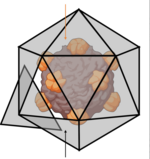
TUESDAY 13 JULY 2020
The Kjems lab is part of Virofight, a new research consortium that has received funding from the EU FET-OPEN program to advance novel antiviral treatment. Instead of targeting virus-specific proteins or enzymes by small molecules as done by current antivirals, the Virofight project will develop DNA-based nano-shells that engulf and neutralize entire viruses. This novel approach has the potential to help fight multiple viruses with one generic approach.
Viral infections affect millions of people every year and cause tremendous human suffering and costs to society. For the majority of all WHO-listed viruses, there is no treatment available and the antiviral drugs that do exist must be applied very early after infection to be effective. The Virofight consortium proposes a new approach to fight viral infections, addressing the lack of broadly applicable antiviral treatments and creating means for combating new viral diseases. The consortium consists of five research groups in Germany, Slovenia and Denmark and is coordinated by Hendrik Dietz at the Technical University of Munich.
Virofight is supported by the European Union’s Horizon 2020 funding program with 3.88 million Euro. The project was initiated on 1st June 2020 and will run for four years.

FRIDAY 10 JULY 2020
We currently have an opening for a PhD student in the Kjems lab. The PhD project is part of the Center for Multifunctional Biomolecular Drug Design - CEMBID - funded by the Novo Nordisk Foundation (www.CEMBID.au.dk) and the workplace will be at iNANO at Aarhus University. The application deadline is August 1st, the earliest starting date is November 1st.
The project - Bioimaging and disease treatment using bioconjugated, multifunctional compounds - is focused on creating multifunctional nanomedicine through rational design and screening analysis in cells and animal models. This will be accomplished by tethering targeting molecules (antibodies, nanobodies, receptor ligands, aptamers) with imaging tracers (fluorescence molecules and radioisotopes for PET imaging) and drugs (toxins, antisense, RNAi, CRISPR/Cas) via advanced bioconjugation chemistry for subsequent testing. The main focus points are imaging and treatment of cancer, inflammation and viral infections (influenza and SARS-CoV2). The project is conducted in close synergy between multidisciplinary groups at iNANO and clinicians.
A full description of the project and the conditions for applying can be found here: The Interdisciplinary Nanoscience Center at Aarhus University: About CEMBID (au.dk)
For more information, please contact Prof. Jørgen Kjems (jk@mbg.au.dk)
To apply for this position go to Nanoscience (au.dk)
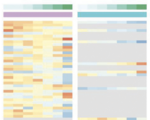
MONDAY 6 JULY
In a new paper, IJu Lo - bioinformatics PhD student in the Kjems lab - analysed RNA-sequencing data from a cohort of Alzheimer's disease patients and found that circRNA expression patterns in specific brain regions differ between patients at different stages of disease severity and the healthy controls. This finding provides a basis for future functional studies to get a better understanding of disease development and could be used as a biomarker set for early screening and diagnosis of AD patients.
IJu is enrolled as an industry PhD student and the study was performed in collaboration with the company Qiagen.
The paper 'Linking the association between circRNAs and Alzheimer’s disease progression by multi-tissue circular RNA characterization' by IJu Lo, Jamie Hill, Bjarni J. Vilhjálmsson and Jørgen Kjems can be found here https://www.tandfonline.com/doi/full/10.1080/15476286.2020.1783487
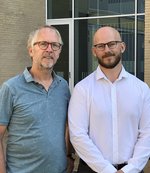
THURSDAY 25 JUNE 2020
A new paper from Jørgen Kjems' group at iNANO and MBG describes how expression of non-coding RNA changes during epileptic seizures in rodents. The authors found that inhibiting a specific set of microRNAs (miRNAs) by antisense technology reduced seizure frequency in a mouse model, suggesting that these RNA molecules could serve as possible targets for future epilepsy therapy.
The work, published in the journal PNAS, was spear-headed by former MBG/INANO-postdoc Morten Venø - now the CEO of AU spin-off company Omiics - and performed in close collaboration with the EU-funded consortium EpimiRNA. The consortium provided state-of-the-art animal models for epilepsy, which were analysed for disease-relevant RNA-expression by the Kjems lab.
Epilepsy is a neurological disorder characterised by recurrent epileptic seizures and it displays a wide range in severity (from mild to highly debilitating) and in susceptibility to treatment. Temporal lobe epilepsy (TLE) is a type of epilepsy characterized by seizures that arise from the hippocampus. Many TLE patients do not respond to drug treatment, often necessitating surgical resection of the brain structures affected. Jørgen Kjems and co-workers extracted brain tissue from three different rodent epilepsy models before and after the onset of epileptic seizures and used Next Generation Sequencing to map changes in expression of small non-coding RNAs. A set of miRNAs was found to respond to seizures in a similar manner in all three animal models, suggesting a general role in epilepsyrather than a species-specific effect. The authors went on to show that inhibition of these epilepsy-regulated miRNAsupon injection of antisense RNA strands reduced the rate of spontaneous seizures in a mouse model. While the underlying molecular mechanism behind this effect remains unclear, bioinformatics and proteomics work suggested the TGFβ signaling pathway to be involved.
The study is a result of more than four years of work in different labs in EpimiRNA and the authors hope that the large amount of sequencing data generated can serve as a resource for future studies on the molecular basis for epilepsy. The paper 'A systems approach delivers a functional microRNA catalog and expanded targets for seizure suppression in temporal lobe epilepsy' is published in the journal Proceedings of the National Academy of Sciences (PNAS).

MONDAY 29th of June 2020
During his PhD studies, Søren Fjelstrup researched characterization of complex biological samples using aptamer libraries. The sensation of taste is produced by innumerable different chemical compounds which are recognized by taste receptors. By producing artificial receptor analogs, we can rival this wide specificity. This allows us to detect complex changes in the body, in which a single measurement is not sufficient. An example of this would be cancer. Using machine learning algorithms, it has been shown in this work that it is possible to translate the signals from millions of these receptor analogs in a way that allows detection of bladder cancer in blood and to distinguish between different beers.
The PhD study was completed at Interdisciplinary Nanoscience Center (iNANO), Faculty of Natural Sciences, Aarhus University.

APRIL 2020
In response to the COVID-19 pandemic, public and private Danish foundations have decided to support projects that offer a deeper understanding of SARS-CoV-2 detection, behaviour, biology and therapy. Two projects in the lab - both utilising the versatility and precision of RNA aptamers - have been launched as a result.
The first project is supported by a Semper Ardens grant from the Carlsberg foundation. The goal is to develop a diagnostic test and alternative treatment options based on new aptamer technologies. Professor Jørgen Kjems from iNANO and the Department of Molecular Biology and Genetics leads the group of AU researchers participating in the project:
“I look forward to starting this project as soon as possible, which is the result of the serious situation in Denmark. We are joining together across many disciplines to solve these tasks with completely new innovative methods. Although we may be late for the current epidemic, I am convinced that, with this research effort, we will be much stronger next time virus ravages the world,” he says.
“For a virus to take over the control of our cells, it must pass through the cell membrane, and this is precisely this initial step in the infection process that we want to block. To that end, we have developed a new type of aptamer, that is, small DNA-like molecules comparable to antibodies. They can be designed to specifically bind all proteins on the surface of the corona virus, giving hope that the drug will also be active against future coronaviruses.”, says Jørgen Kjems.
Read the announcement from the Carlsberg foundation here:
'Stay curious' video explaining the project (in Danish):
https://www.carlsbergfondet.dk/da/Nyheder/Nyt-fra-fondet/Nyheder/Hvordan-bekaemper-forskerne-COVID19
The other project is supported by the Independent Research Fund and is carried out in collaboration with researchers at Rigshospitalet in Copenhagen and the Danish Technical University. Here the focus is to use the so-called 'APTASHAPE' technology, where billions of small biosensor molecules, based on RNA, provide a snapshot of proteins and metabolites in the patient's blood. The ultimate goal of the technology is to create a fast screening platform that can reveal if a person has been infected within a few days and at the same time warn of any complications due to their underlying disease status.
The announcement from the Independent Research Fund Denmark can be found here
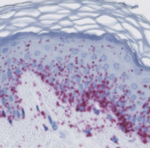
WEDNESDAY 18 DECEMBER 2019
In a new paper from the lab, PhD student Liviu-Ionut Moldovan maps circRNA expression patterns in psoriasis and discusses how reduced circRNA levels in lesional skins may function as biomarkers or potentially contribute to disease development.
Read the full paper here: https://bmcmedgenomics.biomedcentral.com/articles/10.1186/s12920-019-0616-2
Moldovan, L.I., Hansen, T.B., Venø, M.T., Okholm, T.L.H., Andersen, T.L., Hager, H., Iversen, L., Kjems, J., Johansen, C., Kristensen, L.S.: High-throughput RNA sequencing from paired lesional- and non-lesional skin reveals major alterations in the psoriasis circRNAome. BMC Med Genomics. 2019 Nov 27;12(1):174
MONDAY 16 DECEMBER 2019
The results from Rasmus Thomsen's PhD work in the lab are now published in a paper in Nature Communications. Using DNA origami, Rasmus and colleagues in Aarhus, Copenhagen and Germany created a large synthetic nanopore made from DNA. This nanopore structure is capable of translocating large protein-sized macromolecules between compartments separated by a lipid bilayer. In addition, a functional gating system was introduced inside the pore to enable biosensing of very few molecules in solution.
With the use of powerful optical microscopes, the researchers could follow the flow of molecules through individual nanopores. By introducing a controllable plug in the pore, it was furthermore possible to size-selectively control the flow of protein-size molecules and demonstrate label-free, real time, bio-sensing of a trigger molecule.
Lastly the pore was equipped with a set of controllable flaps, allowing targeted insertion into membranes displaying particular signal molecules. In the future, this mechanism will potentially enable insertion of the sensor specifically into diseased cells and may allow diagnosis at the single cell level.
Thomsen, R.P., Malle, M.G., Okholm, A.H., Krishnan, S., Bohr, S.S.-R., Sørensen, R.S., Ries, O., Vogel, S., Simmel, F.C., Hatzakis, N.S., Kjems, J.: A large size-selective DNA nanopore with sensing applications. Nature Communications volume 10, 5655 (2019) https://www.nature.com/articles/s41467-019-13284-1
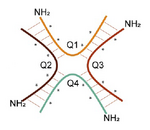
FRIDAY 10 MAY 2019
Nucleic acids provide a versatile, programmable scaffold that allows the construction of highly functionalised molecules. This is illustrated in a recent paper from the lab, A self-assembled, modular nucleic acid-based nanoscaffold for multivalent theranostic medicine, published in the journal Theranostics. In this paper, the authors show that specifically designed RNA oligos can form a stable Holliday Junction - inspired by the four-stranded DNA structures that appear during DNA recombination and repair - that allows the attachment of four different functionalities on extended RNA strands.
Andersen, V. L., Vinther, M., Kumar, R., Ries, A., Wengel, J., Nielsen, J. S. & Kjems, J. (2019). A self-assembled, modular nucleic acid-based nanoscaffold for multivalent theranostic medicine. Theranostics, 9(9), 2662-2677. https://doi.org/10.7150/thno.32060
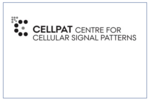
MONDAY 15 APRIL 2019
We currently have an opening for a PhD student in the Kjems lab. The position is funded via the DNRF center CellPAT (www.CellPAT.au.dk) and the workplace will be at iNANO at Aarhus University. The application deadline is May 1st, the earliest starting date is Aug 1st.
The project - Interfacing cells functionally with multivalent, patterned signals - involves molecular design of self-assembled DNA and RNA scaffolds that display functional ligands for cellular uptake, differentiation and immune response, with a particular focus on understanding the importance of spatial organization and multivalency of the ligands. The complexes are investigated functionally in cell-free systems, in cells and eventually in animal models. The main methodologies applied in the PhD study are nucleic acid-based structural design at chemical and molecular level, molecular binding assays, in vitro evolution methods, structure and binding characterization by various biophysical methods and functional implications on cells by flow cytometry, RNA expression profiling, and super-resolution microscopy.
For more information, please contact Prof. Jørgen Kjems (jk@mbg.au.dk)
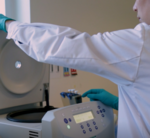
MONDAY 8 APRIL 2019
The Journal of Visualised Experiments (JoVE) challenges the traditional format for research articles by publishing high-quality instruction videos for protocols and new discoveries. A cross-collaborative effort between the two halves of the Kjems lab - involving postdocs and PhD students from both iNANO and MBG - recently led to the publication of a video article in JoVE. The video describes the isolation, sequencing and analysis of extracellular microRNAs from human mesenchymal stem cells.
The full video (and a pdf version of the transcript and protocol) can be found here https://www.jove.com/video/58655/isolating-sequencing-analyzing-extracellular-micrornas-from-human
Yan, Y., Chang, C. C., Venø, M. T., Mothershead, C. R., Su, J. & Kjems, J. (2019). Isolating, Sequencing and Analyzing Extracellular MicroRNAs from Human Mesenchymal Stem Cells. Journal of visualized experiments: JoVE, (145), [e58655].

WEDNESDAY 20 MARCH 2019
We recently hosted 15 PhD students from the circRTrain network (https://circrtrain.eu) for a course held at iNANO/MBG on the 11-14th of March. The course was focused on theoretical and practical training in using Nanopore and Nanostring technology for the sequencing and quantification of RNA.
PhD student I-Ju Lo will have her qualifying exam (del A) on Tuesday the 29th of January. Her progress report is entitled 'Discovering circular RNAs as a biomarker in Alzheimer’s disease with the functional genomics approach' and the examiners are:
Professor Albin Sandelin, Department of Biology, University of Copenhagen
Professor Troels Skrydstrup, iNANO and Department of Chemistry, Aarhus University
Professor Jørgen Kjems, iNANO and Department of Molecular Biology and Genetics, Aarhus University
Mr. Jamie Hill, Qiagen
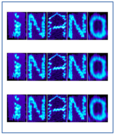
MONDAY 14 JANUARY 2019
The Kjems lab invites applications for two PhD fellowships at the Graduate School of Science and Technology (GSST), Aarhus University, within the Nanoscience programme. http://phd.scitech.au.dk
The first PhD project focuses on the use of a new technology, DNASHAPE, to analyse food ingredients and detect contaminants and pathogens, while the other one uses nucleic acids, protein, lipids and sugars as building blocks for the construction of novel functional nanomachines.
More information about the projects and how to apply can be found here
phd.scitech.au.dk/for-applicants/apply-here/february-2019/analyzing-food-ingredients-by-a-novel-dnashape-technology/ (Call closed)
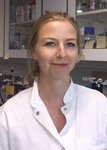
THURSDAY 22 NOVEMBER 2018
Traditional methods for diagnostics and therapy for diseases such as cancer are often imprecise and can therefore be both ineffective and cause severe side effects. In her PhD studies, Veronica Liv Andersen has developed self-assembled nanostructures that can be used to form multifunctional therapeutic systems. By utilizing chemically modified nucleic acids that are structurally and functionally similar to DNA and RNA as building blocks for the scaffold itself, highly well-defined and biocompatible structures can be designed. The design principle investigated in these studies relies on the the production of a number of different functional modules that subsequently can be assembled and combined - much like LEGO bricks - to form a structure that carries exactly the set of therapeutic molecules that are effective in a specific disease in the individual patient. These results thereby contribute new perspectives and methods to the field of personalized medicine and theranostics, the combination of precision therapy and diagnostics.
The PhD degree was completed at the Interdisciplinary Nanoscience Center (iNANO), Science and Technology, Aarhus University.

WEDNESDAY 14 NOVEMBER 2018
The ability to engineer, control, and manipulate molecular assemblies is emerging and one approach to do so involves the use of DNA nanostructures and designs. This approach has evolved immensely since its inception more than 35 years ago. During his studies, Rasmus has designed, developed, and used DNA nanotechnology to engineer peptides, proteins, and lipid membranes. Common to all projects are the use of DNA as a structural scaffold, modified chemically and enzymatically with functional probes. The systems have been uniquely designed towards a desired purpose. Put together, the results demonstrate the versatility and modularity of DNA nanotechnology, which can serve as a nanoscale engineering tool by providing a programmable scaffold.
The PhD degree was completed at the Interdisciplinary Nanoscience Center (iNANO), Science and Technology, Aarhus University.

Professor at Department of Molecular Biology and Genetics and iNANO Jørgen Kjems is receiving the 2018 Novo Nordisk Prize for his pioneering interdisciplinary studies of how RNA, the biological cousin of DNA, plays a key role in regulating cells and has enormous future potential in treating disease. The Novo Nordisk Foundation awards the Prize, which is accompanied by DKK 3 million.
2018.01.31 | CHRISTIAN MOSTRUP SCHEEL OG CHRISTINA TROELSEN
Jørgen Kjems’ scientific activities have always been technically and conceptually innovative. He contributed to challenging a key dogma within human biology early in his career when he and colleagues discovered that RNA has several unexpected key functions in relation to human genes.
At that time, most researchers thought that RNA simply functioned as a messenger between DNA and cellular proteins. “We helped to demonstrate that, in addition to transporting genetic information, RNA also acts as a key regulator of various cell processes. Since then, it has been shown that up to 90% of all RNA probably has other key functions, such as regulating human genes,” says Jørgen Kjems.
Among the many important new scientific breakthroughs to which Jørgen Kjems’ group has contributed, a crucial one was the discovery in 2011 that circular RNA is highly prevalent in most organisms, including people. Circular RNA has a very important role in regulating other genes in the body. In 2013, the research group confirmed in an article published in Nature that circular RNA functions as a kind of sponge that absorbs other RNA molecules and proteins so that they do not affect cellular metabolism. The more than 10,000 types of circular RNA therefore strongly influence the body’s regulatory mechanisms and are therefore also essential in diagnosing, preventing and treating for instance cancer and neurodegenerative diseases.
Jørgen Kjems is receiving the 2018 Novo Nordisk Prize for his outstanding research efforts. The Prize is awarded to recognize unique medical research or other research contributions that benefit medical science. The Novo Nordisk Foundation awards the Prize, which is accompanied by DKK 3 million.
“I am extremely honoured and very surprised to receive the Prize. I am grateful for the recognition of the importance of interdisciplinarity and wide-ranging vision that enables researchers to carry out both basic research and applied research within medicine. I consider this Prize as recognizing not just my research but also that of my colleagues,” says Jørgen Kjems.
Jørgen Frøkiær, Chair of the Novo Nordisk Prize Committee, says, “Throughout his career, Jørgen Kjems has conducted comprehensive, systematic and very original research that has produced pioneering new research on RNA and related fields. The numerous scientific results Jørgen Kjems has achieved through an interdisciplinary approach are both impressive and outstanding. Jørgen Kjems is a very worthy recipient of the 2018 Novo Nordisk Prize.”
Jørgen Kjems has been Professor of Molecular Biology and Nanoscience at Aarhus University since 2003. In 2013, he was appointed Director of the Interdisciplinary Nanoscience Center (iNANO) at Aarhus University, which integrates physics, chemistry, biology and medicine. In 2017, Jørgen Kjems was further appointed Director of CellPAT (Centre for Cellular Cell Patterns), funded by the Danish National Research Foundation. CellPAT aims to identify how cells talk to each other and thereby enable the types of communication errors that lead to disease to be prevented or corrected.

A new basic research centre – CellPAT – will identify how cells ‘talk’ to each other, and thereby make it possible to prevent or correct the type of communication errors that lead to illness.
2017.04.20 | PETER F. GAMMELBY 
Everyone is familiar with the situation where you are about to pay in the supermarket, but have forgotten the PIN code. In this case, the brain searches for clues such as pattern recognition – where do you normally move your fingers, in which order, and how many times do you press each button? The cells in the human body communicate in the same way, only at a molecular level. And just as in the macroscopic world, even small communication errors can cause major problems. When errors occur in cellular communication, the entire organism can become ill. The new Centre for Cellular Signal Patterns (CellPAT) will therefore address fundamental questions in biology to identify how cells ‘talk’ to each other and their surroundings. The Danish National Research Foundation has just decided to provide CellPAT with funds amounting to up to DKK 61 million. The aim is to use advanced nanotechnology to create results that can be ground-breaking in the battle against some of the major health challenges we are facing today – such as diabetes, cancer, osteoporosis, arthritis and certain psychiatric disorders.
Complicated language requires advanced equipment Professor Jørgen Kjems, Aarhus University, takes his point of departure in the fact that the cells communicate through a network of weak interactions that together provide the necessary effect. “The old assumption that cellular macromolecules recognise each other like a key in a lock is not sufficient. On the contrary, the cell communicates by means of complex signals, where the number and particularly the pattern of contact points play an incredibly major role. Until now, the complexity of this interaction has made scientific studies difficult. Using completely new synthesis and analysis methods, however, we can produce and analyse the signals ourselves at CellPAT,” says Professor Kjems, director of the new centre.
The centre will focus in particular on how our immune cells can recognise the difference between external dangers and ourselves, and why this mechanism sometimes goes wrong and gives rise to autoimmune diseases such as arthritis, sclerosis and diabetes. The centre will also study the way macromolecules are transported through biological barriers in the body, such as the blood-brain barrier and cell membranes. This knowledge will form the basis for developing more targeted and effective drugs with fewer side effects. In addition, the centre will study which signals the stem cells need to receive in order to develop into specific types of tissue in the body. This knowledge will create an opportunity to use stem cells to re-establish tissue in the body when the old cells are destroyed by a poor lifestyle, disease or injury. It is thought that the method will eventually be used to regenerate human organs.
Professor Kjems is a very experienced research director and one of the leading international profiles in DNA and RNA nanotechnology, where he is particularly recognised for having moved the research front in self-assembling systems in DNA, intracellular circular RNA and genetic medicine. He has been the director of the Interdisciplinary Nanoscience Centre (iNANO) at Aarhus University for four years.
Participating at the centre are Professor Duncan Sutherland, iNANO, Aarhus University Professor Steffen Thiel, Department of Biomedicine, Aarhus University Professor Fiona Watt, King’s College London, UK Group Leader Dr Ralf Jungmann, Ludwig-Maximilians-Universität Munich (LMU) and Max Plank Institute of Biochemistry (MPIB) Munich, Germany

The Carlsberg Foundation has just awarded ten Semper Ardens grants for a total sum of 117 million DKK.
2016.05.12 | TRINE MØLLER HANSEN
Aarhus University receives six grants of which four go to ST, one of these goes to Jørgen Kjems. In the DNA-SHAPE project, the researchers will develop a new method which will make it possible to "translate" the total content in a specific food to digitized information in the form of DNA sequences. From advanced computer analysis of DNA sequences it will be possible to obtain a digital fingerprint of the food content, which potentially can be used as a marker for food quality, safety and authenticity. Grant recipient: Professor Jørgen Kjems, iNANO Project: Analysis of complex biological mixtures by a novel method: ”DNA-shapes” Grant:6,1 million DKK Project period: 3 years

2015.01.21 | Rebeca Suarez Alvarez Thostrup
Professor Jørgen Kjems, the new director of iNANO. Photo: Lars Kruse, AU Communication
Professor Jørgen Kjems has been appointed director of the Interdisciplinary Nanoscience Centre (iNANO) for a three-year period. He has been an integrated part of the management at the centre for a number of years, both as a founding member of iNANO and as acting director since 2014.
Professor Kjems studied at Aarhus University, where he completed his PhD in Biostructural Chemistry in 1989 at the Department of Chemistry. He subsequently spent three years as a postdoctoral fellow at Harvard and the Massachusetts Institute of Technology (MIT) in Cambridge, USA, prior to returning to Aarhus. He was appointed associate professor at the Department of Molecular Biology and Genetics in 1994 and professor in 2003.
With a main field of research in nanomedicine, Professor Kjems has over the years contributed with world-class research in this area, and he has built up a large international network. He has published approximately 250 scientific articles and has 10,000 citations. His latest major discovery, which was published in Nature in 2013, is the presence of a new type of circular RNA molecules in human cells that can be used as both disease markers and nanomedicine.
Professor Kjems is also principal investigator (PI) of the LUNA Centre (the Lundbeck Foundation Nanomedicine Centre for Individualized Management of Tissue Damage and Regeneration), and he participates in a number of other centres – the Centre for DNA Nanotechnology (CDNA), the Biomolecular Nanoscale Engineering Centre (BioNEC) and Aarhus University’s Centre for Integrative Sequencing (iSEQ).
Over the years, Professor Kjems has received a number of awards, and he is a member of several academic councils.
He was born in 1959 and is married to Lena, a minister of religion in Vejlby. They have three children and live in the Aarhus suburb of Risskov.
For more information, please contact
Professor Jørgen Kjems
Director of iNANO
Aarhus University
Mobile +45 2899 2086
kjems@inano.au.dk
Article by Anne- Mette Siem![]()